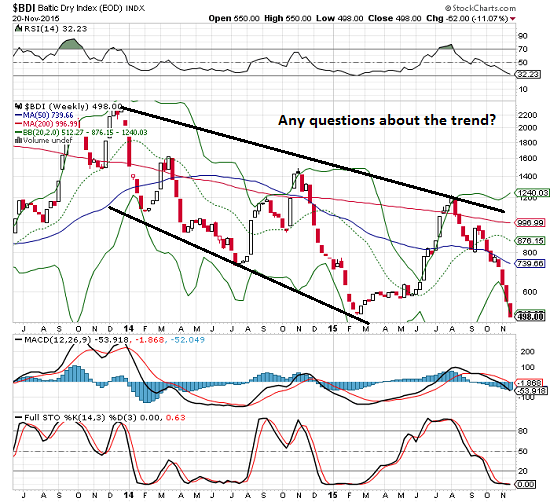If container shipping is any reflection of the upcoming Christmas season, Santa is poised to fill the nation’s Christmas stockings with coal. Let’s start by noting that Baltic Dry Index Falls Below 500 for First Time Ever (gcaptain.com) and Container Freight Rates Plummet 70% In 3 Weeks (Zero Hedge).

For a corroborative report on shipping along America’s Atlantic Coast, we turn to correspondent J.M., who works in the shipping industry. Here’s is J.M.’s sobering first-hand observations:
We just arrived back in New York after a multi-port run down the Atlantic seaboard. My observations of the box ship trade in and out of those major ports, as well as coastwise between the ports, is that business is dismal.
I’ve never seen so many big container ships running around high in the water with nearly empty decks and holds. Not even in 2008-2011.
Admittedly, these are only anecdotal observations. And I’m well aware of the confirmation-bias tendencies we are prone to. Having said that, my experienced eye calculated that less than a third of the dozens of box ships I’ve seen this past 2 weeks were “normally” loaded, meaning roughly 2/3 to 3/4 of capacity or better. About half were obviously very light on cargo, 1/3 or less.
The most consistently glaring anomaly: the empty deck space, with lots of bottom paint showing. Translation: little cargo, and they weren’t even deadheading empty boxes around between ports to keep the global system supplied logistically.
Aside from the record-low BDI, an obviously ominous canary-in-the-coal-mine moment by my reckoning.
Thank you, J.M., for the first-hand report. Now perhaps the all-important Christmas Industry received all its goodies in September, and the current flotilla of nearly empty container ships is not relevant to the coming shopping season.
But the pathetically frantic poaching of retailers suggests otherwise. The tsunami of web, email, print and mail adverts are reeking of desperation–a desperation to snag the few dollars consumers are willing to spend this holiday season before some competing retailer entices the tightfisted consumer first.














Leave A Comment